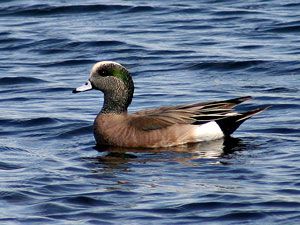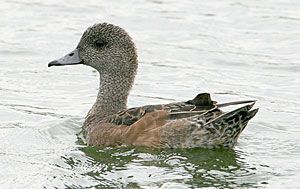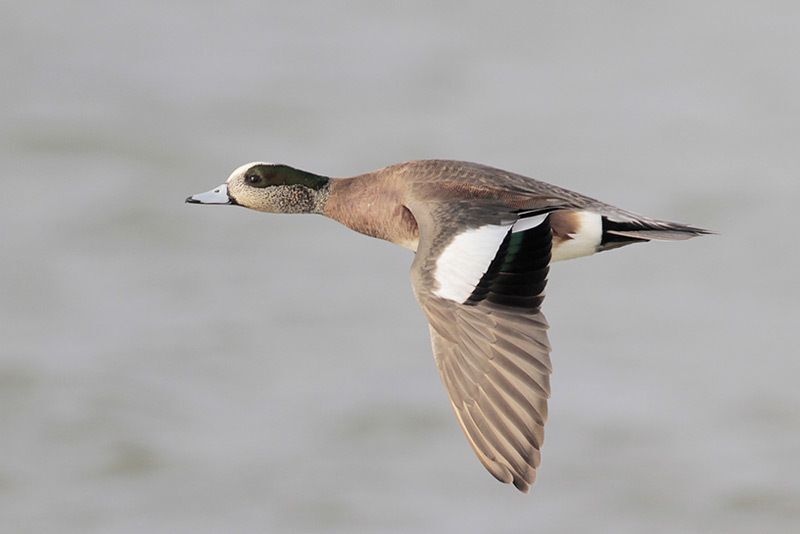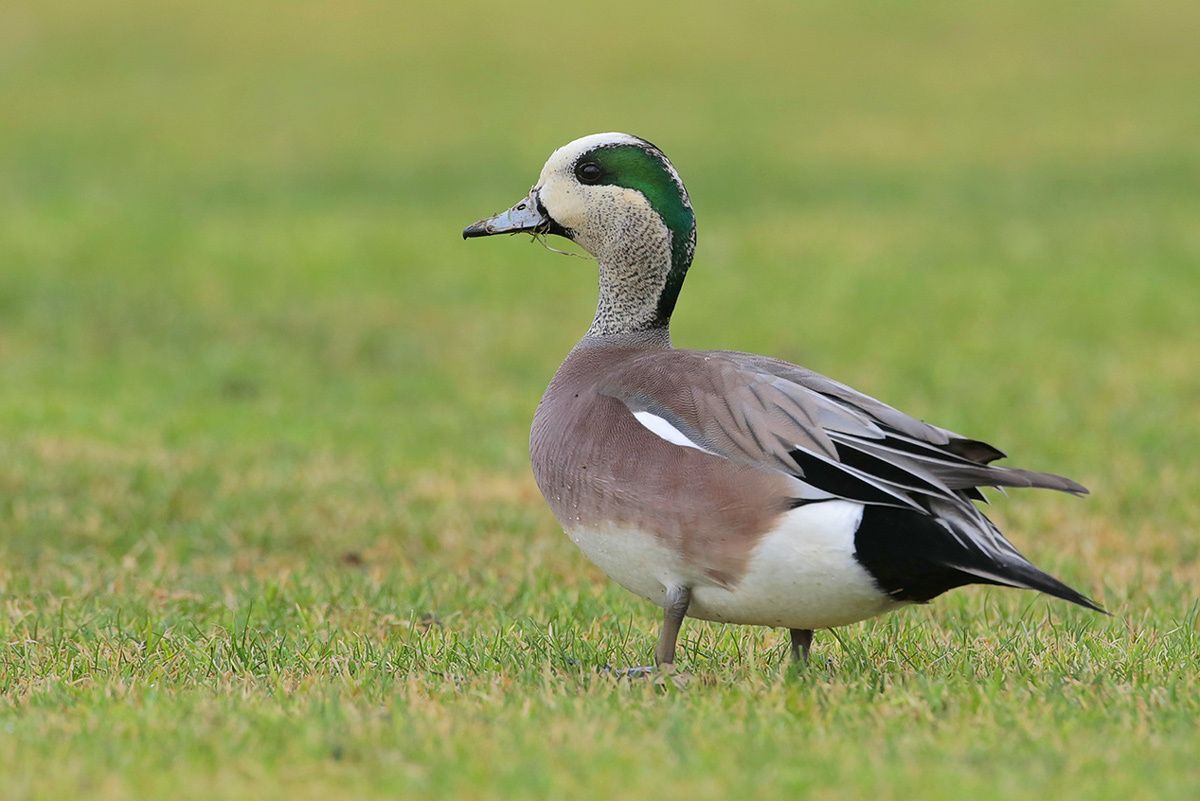American Wigeon

© Helen Baines
Mareca americana
Family: (Anatidae) Ducks, Geese, and Swans
Preferred Habitat: Lakes and marshes.
Seasonal Occurrence: Common October through April.
Profile by Abby Ficklin: The American Wigeon, once known as the Baldpate for the male's white crown, breeds throughout Alaska, Canada’s Northwest Territories and America’s mid/northwest regions. During breeding season the drake (male) is most distinguishable by his white crown, iridescent green post-ocular stripe, and dark brown back. While the female lacks aforementioned characteristics, she is recognized by her mottled gray head. Both have a rusty colored breast/flank and bluish-gray bill with a diagnostic black tip. Another field mark is the white shoulder patch seen in flight.
This medium-sized duck migrates along the central flyway down to the southern US, Central America, and northern South America. In addition, they are found wintering on North America's west and east coasts. American Wigeon’s favor shallow waters or small ponds, however they are also found in deep water where they have been observed kleptoparasitizing food from diving ducks. Commonly feeding on the surface of the water the wigeon ingests a greater amount of plant matter than any other dabbling duck species. This is probably because of its short bill which supports more force when foraging for plants.
During courtship a female usually has many male suitors that demonstrate tail-wagging, wing-flapping, head-turning and abrupt leaps from the water for her. Once the female has made her choice, she finds a dry, vegetated area to nest, then creates a small depression and fills it with grasses, weeds, and feathers. A female has one brood with 5-12 white eggs. She will care for these nestlings and fledglings for up to 3 months.

© Greg Lavaty, www.texastargetbirds.com
Profile by Jon Piasecki: The American Wigeon is a species of dabbling duck that can be found throughout the United States on ponds, lakes, and marshes. These birds breed in the northwestern U.S., the western half of Canada, and Alaska. They can be seen migrating during the spring in small flocks of less than 50 individuals and during the fall in larger flocks of over 100 birds. Their wintering range extends along the Pacific coast, through the Midwest and southern U.S., and along the Atlantic coast. Some populations of American Wigeon also extend their wintering range into Mexico, parts of Central America, the Caribbean, and the northern tip of South America.
Male American Wigeons are known for their distinct green stripe behind their eyes along with a bright white crown. They also show a very bright white patch on their upper wing during flight. Females have an overall brown-gray head with a dark patch surrounding the eye. Both sexes have a pale blue bill with black at the tip. During the winter season, males begin their courtship displays and fight off other males while competing for a mate. Some of these displays include the male wagging its tail, extending its neck, and raising its wings to show off its white wing patches, and shaking its wings out for the female to see. Often males can be heard whistling in a very high pitch. Once a pair is formed, they migrate to the breeding ground together.
American Wigeon nests are often built by forming a depression in the ground and lining it with a variety of materials such as cattails and feathers. Typically, between 3-13 eggs are laid and can take up to 28 days to hatch. American Wigeons feed almost entirely on plant species. They are very commonly seen taking tiny bites at plants floating on the water’s surface or tipping their backside up and head under water to feed on vegetation below the surface. However, during the breeding season, females can be seen consuming insects because their bodies need extra protein for the egg laying process.
This time of year (December-January), American Wigeons can be seen throughout Texas in marshes, ponds, and lakes. Some great nearby locations to see these birds include the ponds at Smith Oaks Bird Sanctuary in High Island and Horseshoe Marsh Sanctuary along the Bolivar Peninsula. Be sure to get out and get a look at these birds before they begin their migration in the spring!
-
Cornell Lab of Ornithology
-
Field Guide

© Greg Lavaty, www.texastargetbirds.com

© Greg Lavaty, www.texastargetbirds.com

© Greg Lavaty, www.texastargetbirds.com

© Greg Lavaty, www.texastargetbirds.com




















